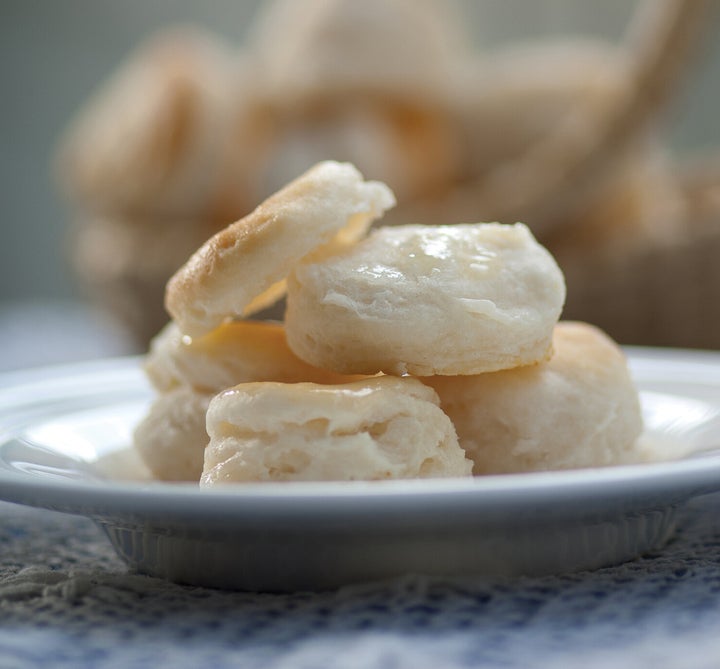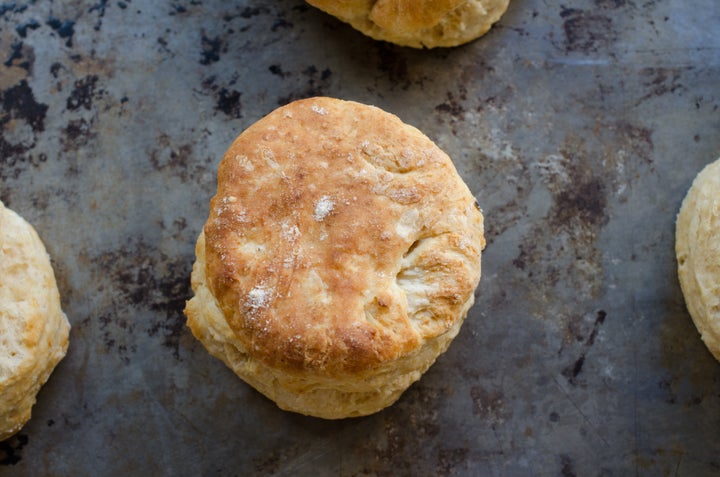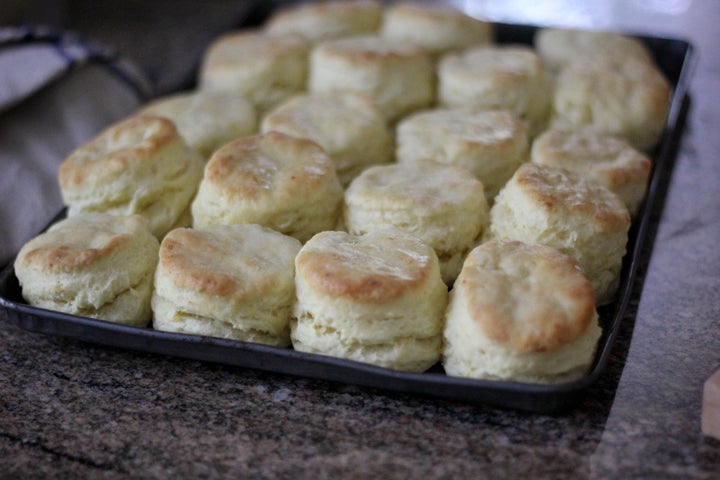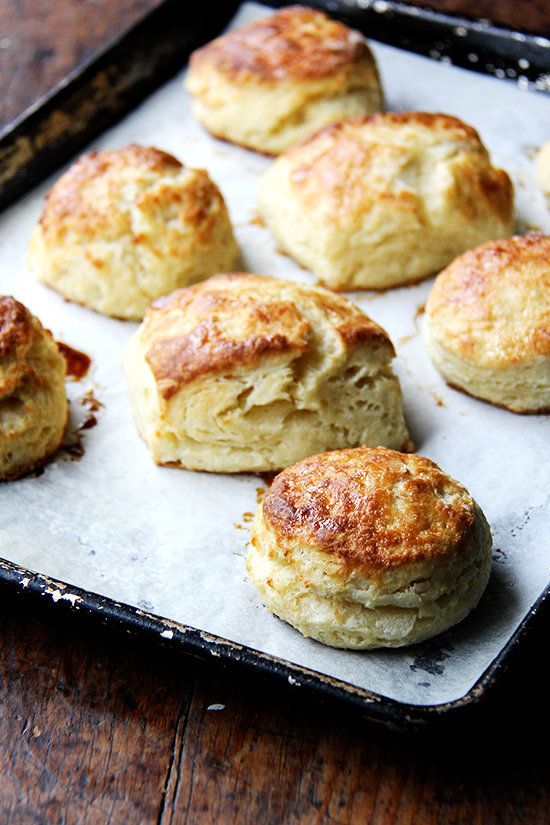Are you terrified of making biscuits? Does being alone in the kitchen with a biscuit recipe makes you a nervous wreck? Not to worry.
These three Southern cooking legends agree that biscuit-making is a technique that takes some time to learn, and each highlights a different way to achieve biscuit success. There’s not just one right way to make a biscuit.
Biscuit #1: Delicate, light-as-air and made with two ingredients.
Nathalie Dupree, the queen of Southern cooking, laments the lack of culinary education for making biscuits: “It’s just that no one ever bothered to say that making Southern biscuits was a technique worth learning, like meringues or béchamel sauce.”
The small, light and tender biscuits Dupree makes are barely strong enough to hold a piece of sausage or country ham, and delicate enough that they might tear apart at the last bite. They certainly aren’t bready, and never thick like a biscuit made in a fast-food place, where they don’t know better.
“Biscuits-making wasn’t taught, it was just done, and you had to watch someone else do it sitting there as a child,” Dupree told HuffPost. “If I’d made biscuits every day for 60 years like my friend Kate Almand, I would just grab the Crisco and the milk cold from the fridge and pour them in the center of my biscuit bowl of flour. Then I’d mix and shape them by hand, each perfect every time.” But that’s not Dupree’s life, and it likely isn’t yours.
Dupree’s favorite biscuit recipe needs just two ingredients — self-rising flour (preferably a Southern brand like White Lily) and heavy cream—making it a simple, go-to recipe for inexperienced cooks. Lightly mixing and folding are the essential techniques to her tender biscuits. Plop the wet dough onto a flexible plastic cutting mat sprinkled with flour and use it to help fold the dough over itself about three times, patting it out to the desired thickness. “Folding stops you from fondling the dough, which is such a temptation,” Dupree said.
We can assure you there will be plenty of fondling when these ethereal puffs come out of the oven.
Nathalie Dupree’s Cream Biscuits
Maks 6-8 two-inch biscuits, or 12-14 one-inch biscuits.
2 1/4 cups self-rising flour, divided
1 1/4 cups heavy cream, divided
Salted butter, softened or melted, for pan and finishing
1. Preheat oven to 450 degrees Fahrenheit. Select a baking pan by determining if a soft or crisp exterior is desired. For a soft exterior, use an 8- or 9-inch cake pan, individual pizza pan or an ovenproof skillet where the biscuits will nestle together snugly, creating the soft exterior while baking. For a crisp exterior, select a quarter-sheet pan or other baking pan in which the biscuits can be placed farther apart, allowing air to circulate and create a crisper exterior. Butter the pan.
2. Fork-sift or whisk 2 cups of the flour in a large bowl, preferably wider than it is deep, and set aside the remaining 1/4 cup of flour. Make a deep hollow in the center of the flour by pressing with the back of your hand. Slowly but steadily stir 1 cup of cream, reserving 1/4 cup cream, into the hollow with a rubber spatula or large metal spoon, using broad circular strokes to quickly pull the flour into the cream. Mix just until the dry ingredients are moistened and the sticky dough begins to pull away from the sides of the bowl. If there is some flour remaining on the bottom and sides of the bowl, stir in just enough of the reserved cream to incorporate the remaining flour into the shaggy, wettish dough. If the dough is too wet, use more flour when shaping.
3. Lightly sprinkle a flexible plastic cutting mat, wooden board or other clean surface with some of the reserved flour. Turn the lumpy, wettish dough out onto the board and sprinkle the top of the dough lightly with flour if sticky. With floured hands, fold the dough in half and pat it into a 1/3-to-1/2-inch-thick round, using a little additional flour only if needed. (If using the flexible plastic mat, fold the mat over itself to fold the dough.) Flour again if sticky and fold the dough in half a second time.
4. If the dough is still clumpy, pat and fold a third time. Pat dough into a 1/2-inch-thick round for normal biscuits, a 3/4-inch-thick round for tall biscuits, or a 1-inch-thick round for giant biscuits. Brush off any visible flour from the top. For each biscuit, dip the biscuit cutter into the reserved flour and cut out the biscuits, starting at the outside edge and cutting very close together, being careful not to twist the cutter. The scraps may be combined to make additional biscuits, although they will be tougher.
5. Using a metal spatula if necessary, move the biscuits to the pan or baking sheet. Bake the biscuits on the top rack of the oven until light golden brown, about 10 to 14 minutes. After 6 minutes of baking, rotate the pan in the oven so that the front of the pan is now turned to the back, and check to see if bottoms of the biscuits are browning too quickly. If so, slide another baking pan underneath to add insulation and retard the browning. Continue baking another 4 to 8 minutes, until the biscuits are light golden brown. When they are done, remove from the oven and lightly brush the tops with softened or melted butter. Turn the biscuits out upside down on a plate to cool slightly. Serve hot, right side up.
Reprinted with permission from “Southern Biscuits” by Nathalie Dupree and Cynthia Graubart. For more information, please visit www.nathaliedupree.com.
Biscuit #2: Tender (but slightly sturdier) pat-and-fold biscuits.
Virginia Willis, chef and James Beard Award-winning cookbook author, calls her Southern biscuits “the bread of my people.” She’s more apt to make a batch for a weekend brunch or a special dinner, as biscuits are no longer an everyday bread for her, and well, for most of us.
“Biscuits are more of a treat than not because they are more indulgent, so I’ll make a batch for a big casual lazy brunch with grits, eggs and bacon, and certainly for entertaining, especially with non-Southerners at the table,” Willis told HuffPost. “Southern biscuits really have become a celebration bread.”
Like Dupree, she preaches the gospel of Southern flours for the low protein (low gluten) levels that bring lightness to a biscuit. The real secret is to not overwork the dough. “You don’t really finish the dough in the bowl but rather on the floured board. Use a bench scraper to shore up the dough into a rectangle, keeping your hot little hands from heating up the butter.” While Dupree uses the pat-and-fold method, Willis rolls out her dough before cutting.
Temperature is key in biscuit-making. Keep the oven hot and keep the ingredients cold. “The cold butter in the dough melts once the dough is in the oven and creates steam that helps make the biscuit tender and fluffy,” Willis said.
Home cooks are afraid of making biscuits, fearing they will do something wrong and the biscuits will be dry. “If you are worried as you are working with the dough, just add more buttermilk and drop the dough by spoonfuls onto the baking sheet. Anybody can make a drop biscuit.” And anybody can make a good buttermilk biscuit following Willis’ instructions.
Virginia Willis’s Buttermilk Biscuits
Makes about 20 biscuits.
2 cups White Lily or other Southern all-purpose flour, or cake flour (not self-rising), more for rolling out
1 tablespoon baking powder
1 teaspoon fine sea salt
4 tablespoons (1/2 stick) cold unsalted butter, cut into bits and chilled
3/4 to 1 cup buttermilk
1. Preheat the oven to 500 degrees Farenheit. In a bowl, combine the flour, baking powder and salt. Using a pastry cutter or two knives, cut the butter into the flour mixture until it resembles coarse meal. Pour in the buttermilk, and gently mix until just combined.
2. Turn the dough out onto a lightly floured surface. Knead lightly, using the heel of your hand to compress and push the dough away from you, then fold it back over itself. Give the dough a small turn and repeat 8 or so times. (It’s not yeast bread; you want to just barely activate the gluten, not overwork it.) Using a lightly floured rolling pin, roll the dough out 1/2 inch thick. Cut out rounds of dough with a 1 1/2-inch round cutter dipped in flour; press the cutter straight down without twisting so the biscuits will rise evenly when baked.
3. Place the biscuits on an ungreased baking sheet about 1 inch apart. Bake until golden brown, 8 to 10 minutes. Transfer to a rack to cool just slightly. Serve warm.
Reprinted with permission from “Bon Appétit, Y’all by Virginia Willis.” For more information, please visit www.virginiawillis.com.
Biscuit #3: Sturdy and made with butter and shortening.
Erika Council, of the wildly popular Bomb Biscuits Pop-up in Atlanta, blogs on her recipe site Southern Soufflé and is a software engineer by trade. She likes a sturdy biscuit that’s crisp on the bottom and will hold a piece of country ham or a fried chicken thigh without falling apart.
“We always ate biscuits with something else, so we didn’t want them crumbling, or dissolving into the gravy,” she told HuffPost.
Sturdier than Dupree’s biscuits, Council uses national brand all-purpose flour so her biscuits won’t fall apart. “We didn’t have fancy flours growing up, so we used what was at the store,” Council said. “It was really out of necessity — there wasn’t a choice.”
Council makes biscuits pretty regularly on the weekend and sometimes even makes some for the freezer. Her go-to recipe is a buttermilk biscuit that uses both butter (for flavor) and vegetable shortening (for lightness). “My grandmother used shortening only because butter was expensive. I do love the taste of butter in a biscuit.”
Using hands to cut the fat into the flour is traditional, but Council says her hands are naturally hot so when she’s ready to turn out the dough, she uses a rolling pin instead of patting out the dough. “I like to fold the dough like you do making pastry so you can really get those great layers. Store-bought flaky-layers biscuits are manipulated with egg to give them those layers, but folding the dough helps create those pull-apart layers, too.”
Like Dupree and Willis, Council believes the ingredients should be cold, but she takes it a step further by refrigerating the flour and fat mixture for 15 minutes before adding the cold liquid.
Her most important lesson for new bakers, though, is to keep doing it. “Find a basic recipe and keep making them until you get it right. You’ve got to get a feel for the dough. It’s trial and error,” she says.
Erika Council’s Biscuits with Syrup Butter
Makes 12 two-inch biscuits.
2 1/2 cups all-purpose flour
1 tablespoon baking powder
1/2 teaspoon baking soda
1 teaspoon salt
2 tablespoons vegetable shortening, chilled and cut into 1/2-inch chunks
8 tablespoons (1 stick) unsalted butter, chilled and cut into 1/4-inch slices
1 3/4 cup chilled buttermilk
Syrup Butter: 2 tablespoons unsalted butter melted with 1 teaspoon cane syrup
1. Adjust the oven rack to middle position and heat oven to 450 degrees Fahrenheit.
2. In a large bowl, whisk together flour, baking powder, baking soda and salt. Add shortening into the flour and mix together by breaking up the chunks with your fingertips until only pea-sized pieces remain. Work the butter slices into the flour mixture the same way until butter is incorporated. Place the mixture into the freezer for about 15 minutes.
3. Add buttermilk to chilled flour mixture. Stir with a fork until dough forms into a ball and no dry bits of flour are visible. The dough will be shaggy and sticky. Turn dough out onto a floured surface and dust it lightly with more flour.
4. With floured hands, pat the dough into about 1/2-inch thick rectangle. Fold the dough into thirds, dusting lightly with flour as needed. Lift the short end of the folded dough and fold into thirds again, forming a rectangle. Repeat this process one more time.
5. Cut the dough into 2-inch circles using a biscuit cutter. Be sure to press the cutter down into the dough firmly and do not twist it. Twisting it will seal off the biscuit edges, preventing the biscuits from rising. Place biscuit rounds 1 inch apart on a baking sheet. Brush the tops with melted syrup butter.
6. Bake for 15 minutes or until tops are golden brown. Remove biscuits from the oven and allow to cool slightly before serving.
Reprinted with permission from Erika Council, copyright © 2019. For more information, please visit www.southernsouffle.com.
Source: Read Full Article



